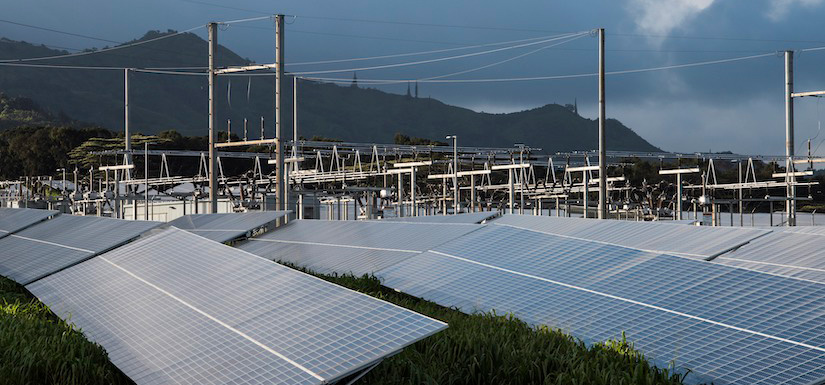How Extreme Weather and System Aging Affect the US Photovoltaic Fleet
Massive Data Set of Photovoltaic System Performance Quantifies the Small but Significant Impacts of Extreme Weather and Long-Term Degradation, With Important Lessons for the PV Industry

For photovoltaic (PV) systems—designed to operate over lifetimes of 20, 30, or even 50 years—small losses in energy production can add up to measurable differences over time. These differences can even determine whether a system operates at a profit or loss. Yet, small changes in energy production are frustratingly difficult to measure, especially in the noisy and often incomplete data of a PV system's production.
After four years of work, National Renewable Energy Laboratory (NREL) researchers have compiled a data set from an unprecedented number of PV systems across the United States—data streams from 25,000 inverters across almost 2,500 commercial- and utility-scale PV sites in 37 states and U.S. territories. By cleaning and averaging data from a huge set of systems, the PV Fleet Performance Data Initiative (PV Fleet) offers a clearer-than-ever look at the health of the U.S. PV fleet and reveals some of the factors that are impacting its performance.
Long-Term Degradation of U.S. PV Systems Matches Expectations
The performance of all solar panels is expected to degrade over time due to exposure to the elements. However, a range of factors drives degradation and the average rate of PV performance loss, which is often debated.
In 2022, in their first major finding, the PV Fleet team found a national median loss in performance of 0.75%/year, confirming similar values reported by previous studies that analyzed smaller data sets. Additionally, the new analysis discovered that systems in hotter temperature zones exhibited about twice as much performance loss as those in cooler climates (0.88%/year and 0.48%/year loss, respectively).
This histogram displays the spread of performance loss rates from the systems studies in the PV Fleet data set. The median loss rate was 0.75% per year, and 90% of studies systems saw losses in performance of less than 2% per year.
"This median loss in performance is a crucial number," said Chris Deline, a group manager for PV field performance at NREL and author on the PV Fleet publications. "First, it shows that our fleet of PV systems, on the whole, is not failing catastrophically, but rather degrading at a modest rate within expectations. It's important that we quantify this rate as accurately as we can, because this small but tangible number is used in almost all financing agreements that fund solar projects and provides critical guidance for the industry."
Extreme Weather's Frequency Is Increasing, But How Big Is Its Impact?
Extreme weather events—flooding, high winds, hail, wildfire, and lightning—can damage fielded PV systems and certainly contribute to long-term performance loss. But how large of an impact does extreme weather have across PV systems in the United States, and are the impacts seen more in the short term or long term?
In a new paper, published in the IEEE Journal of Photovoltaics, researchers used the scale of the PV Fleet data set to quantify some impacts of extreme weather. By comparing the performance of systems in the PV Fleet data set against a National Oceanic and Atmospheric Administration (NOAA) map of extreme weather events, the researchers studied how each system's performance was affected when an extreme weather event occurred within 10 kilometers of its location.
For Most Systems, Short-Term Impact of Extreme Weather Is Minimal
Overall, the short-term outages caused by extreme weather—such as outages due to PV modules being disturbed by strong winds or inverters being damaged by flooding—have a minimal impact on most systems. Over the 2008–2022 time range studied, the PV Fleet team found that the median outage length after an extreme weather event was two to four days, resulting in only a 1% median loss in annual performance. A very small number (12 systems out of 6,400) experienced much longer outages of two weeks or more.
Most outages occurred because of flooding and rain, followed by wind events. And most systems in the data set only experienced one weather-related outage.
When Powerful Enough, Extreme Weather Accelerates Long-Term Degradation
Short-term outages and production losses are not the only impact of extreme weather. Mechanical stresses from wind, hail, and snow can lead to cracked cells within PV modules and other forms of PV system degradation.

A clear trend emerged in the long-term performance of PV systems after exposure to extreme weather events. After weather events above certain thresholds—hail greater than 25 millimeters (1 inch) in diameter, winds in excess of 90 kilometers/hour (56 miles/hour), or snow depths greater than 1 meter—systems showed greater annual performance losses. Below these thresholds, systems experienced performance losses similar to the PV Fleet average.
Even systems composed of modules qualified through International Electrotechnical Commission (IEC) 61215—the industry standard that includes a test for resistance to impact by 25-millimeter-diameter hail—showed higher performance loss rates when exposed to that same size hail in natural settings. This suggests a need for more stringent hail testing (and such a standard is currently under development, published as technical specification IEC TS 63397 in 2022).
Systems damaged by winds above 90 kilometers/hour also displayed an interesting trend, with parts of some systems avoiding damage, possibly due to site-specific phenomena such as wind shadowing from adjacent structures, which helps reduce wind speeds.
How Can We Detect Hail or Wind Damage in Fielded PV Modules?
Watch how the Durable Module Materials Consortium is testing a new, low-cost approach
in the middle of the night.
Best Practices for the PV Industry To Counter Extreme Weather's Impact
"We don't feel any of this analysis suggests that PV systems are unreliable or especially vulnerable to extreme weather," said Dirk Jordan, a distinguished member of research staff at NREL and author on the PV Fleet publications. "PV has demonstrated that it can provide backup power and save lives when surrounding infrastructure is damaged by extreme weather events. Yet, there are further measures we can take to improve the quality of equipment and especially installation best practices to increase resilience to these weather events."
To harden PV systems against the impacts of extreme weather, module manufacturers and PV testing organizations need to first understand the thresholds at which damage can occur. Then, the industry can begin to design for these conditions and—crucially—create tests that subject panels to realistic stresses. The recent development of a new hail testing specification is a good step in this direction, but more rigorous testing standards for wind and snow loading should also be considered.
"High-quality installations are also key to increasing resilience against extreme weather. Standardizing installation practices, such as using through-bolting and mounting modules far enough from the edge of roofs in wind-prone areas, could help mitigate system performance impacts," Jordan said. Several best practices guidelines to increase PV system resilience to storm damage and hail damage have been collected on the U.S. Department of Energy's website and in an NREL fact sheet.
Those who operate and maintain PV systems should also be aware of the extreme weather thresholds reported in these PV Fleet publications so they know when to further analyze impacted systems. And companies that provide PV system insurance may want to support new, more robust tests, especially in regions with the fastest-growing rates of extreme weather.
Finally, the industry should be aware that recent trends, such as larger modules, thinner cells, and thinner front glass, may increase system vulnerability if not designed and tested appropriately. Harmonizing operations and maintenance records and closely monitoring PV assets will enable proactive detection of potential degradation caused by new module designs.
PV operators interested in providing data to the PV Fleet Performance Data Initiative—in return for a customized performance analysis performed by NREL—should contact [email protected].
Unique Data Set Enables New Insights
The new findings were only possible due to the unique scale and data quality of PV Fleet. Numerous PV system operators submitted detailed system data to NREL on the condition that it would be anonymized. In exchange for contributing data to the PV Fleet data set, system operators received customized analyses of their systems' performance.
This map shows the distribution of systems that contributed data to the PV Fleet Performance Data Initiative data set, categorized by the climate temperature zone of their location.
The project has collected 25,000 inverter data streams from almost 2,500 commercial and utility PV sites—representing more than 8 gigawatts of the 72-gigawatt U.S. solar fleet. The mean age of systems in the data set is 5 years.
The PV Fleet team considered data on module technology, system size, and geographical location, as well as operations and maintenance records. Data cleaning and quality assurance were key, requiring extensive human review and machine learning to filter out shifts in weather, interruptions in data feeds, and quirks in system operation.
The PV Fleet Performance Data Initiative was launched in 2019 with support from the U.S. Department of Energy Solar Energy Technologies Office.
Learn more about the PV Fleet Performance Data Initiative.
Learn more about NREL's PV performance research.
PV operators interested in providing data to the PV Fleet Performance Data Initiative should contact [email protected].
Last Updated May 28, 2025
